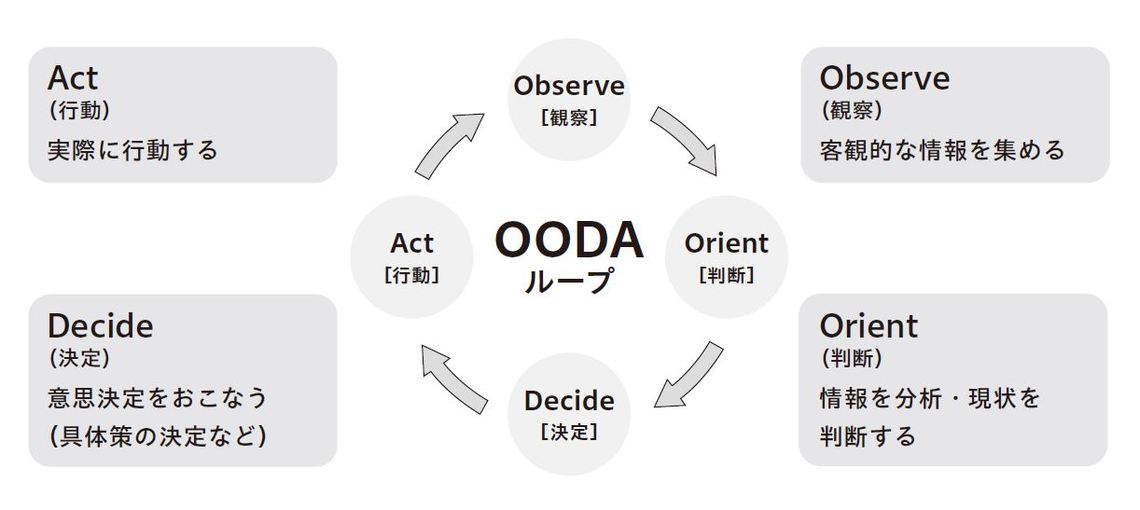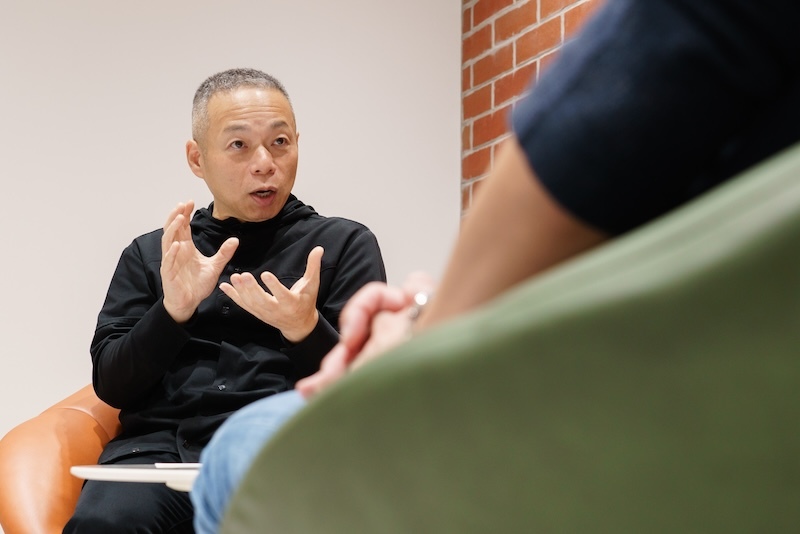The " OODA " loop is gaining attention as a decision-making model that guides solutions to the rapidly changing business challenges of today.
This series shares insights on OODA's appeal and leadership essentials for the future through dialogues with "OODA practitioners" across diverse industries.
Continuing from last time, we present a conversation between Katsu Akai, a globally active floral artist specializing in "flower arrangement," and Aaron Zu, author of " OODA-Style Leadership: The World's Most Powerful Doctrine " (Shuwa System).
This time, we delve into Mr. Akai's secrets for creativity and team building.
【What is OODA?】

A decision-making and action process proposed by John Boyd, a former U.S. Air Force Colonel and fighter pilot. The term OODA is an acronym for Observe, Orient, Decide, Act. Its purpose is to consistently take the best course of action in constantly changing, unpredictable situations. In Western business and marketing, OODA is recognized as an essential decision-making process alongside the traditional PDCA cycle. ( Learn more here ).
Observing the same place from a different angle
Aaron: Last time, you shared about your work as a floral designer and the meaning behind the name "Hanabito." This time, I'd like to delve deeper into your approach to work and creativity. First, what process do you follow to create a piece after receiving a commission?
Akai: For example, with event floral arrangements, I first speak in detail with the organizer or producer about the event's purpose and the sentiments behind it. Through conversation, they often share various keywords – things like "We're really focused on this aspect this time" or "These types of people will be attending." Hints are often hidden in small remarks, so meeting and talking directly with the client is crucial.
Aaron: That's true. Beyond the conversation itself, you also draw inspiration from the client's vibe and the overall atmosphere, right?
Akai: Exactly. That's why I always visit the site. I observe everything, including the overall atmosphere. And even in the same place, changing your perspective can lead to new discoveries.
Aaron: What do you mean by "changing your perspective"?
Akai: For example, when decorating the entrance with flowers, the view differs depending on whether guests arrive by taxi and get out right in front, or drive their own car to the parking lot and walk in. The time of arrival matters too. What time do they typically come, and how is the sunlight at that time? I verify the view from every possible angle, one by one.
Aaron: I see. So first, you gather information. Even within the "Observe" phase of the OODA loop, you emphasize observing things objectively.
Akai: After gathering all the information, we consider what feelings we want the guests to experience and how to style the space. For example, for a conversation between Aaron and a guest, the standard approach is to place flowers on either side or behind them. But if we completely cover an entire wall with flowers, or lay them out like a carpet across the entire floor, it creates a much more flashy and glamorous impression, right? Or, we could deliberately place flowers only behind Aaron. Then, at the end of the talk, he could conclude by saying, "Normally, we'd place flowers behind the guest, right? But I wanted you to see the flowers the whole time we were talking, so I had them placed here." That kind of staging is possible.
Aaron: That's fascinating. When implementing OODA in business, I believe "unconventional strategies" that spark surprise and excitement—making people think "I never thought of that!"—are crucial. Professor Akai's floral arrangements truly showcase that kind of creative ingenuity.

©️Akai Masaru
Everyday "discoveries" are the source of creativity
Aaron: To keep producing such creativity, is there anything you consciously do in your daily life?
Akai: I value discovery. I often go to the basement food halls of department stores. Even though I usually follow the same route, sometimes I stop somewhere different than usual. This happens for various reasons: a store might have changed and a new one moved in, the atmosphere might have changed after a renovation, the staff might have changed, or the products might have changed.
At those moments, I ask myself, "Why did I stop now?" Then I notice things like, "Oh, the lighting changed after the renovation," or "This new product caught my eye," or "The color combination of this display and the product feels fresh to me," or "Taking a different escalator down changed my perspective." I think those discoveries are important.
Aaron: I see. Precisely because it's a route you take every day, you might notice something off.
Changing the subject, at OODA, leadership that guides the team in the right direction is crucial for improving decision-making accuracy and speed. Professor Akai, you often work in teams too, right? What do you prioritize in team building?
Akai: When brainstorming ideas, I try to avoid formal, face-to-face meetings. In those kinds of meetings, everyone only says the right things (laughs). Instead, I often get more useful hints from casual conversations during commutes about topics unrelated to work, or from offhand comments someone makes while tidying up.
Aaron: Are you the type to listen to your team members and younger staff?
Akai: I used to decide things myself, telling people what to do. But as I've gotten older, I've started relying on everyone more. The people closest to me are the ones who see me most objectively. They come up with ideas that are bolder than what I'd think of myself, and I incorporate those too. They really help me see myself and the flowers from different angles. It might sound presumptuous to say, but I truly think they're my greatest asset.
Engaging with Floral SDGs
Aaron: Mr. Akai, you've shaped the feelings and thoughts of many people through floral design. Are there any themes you'd like to engage with going forward?
Akai: I absolutely love flowers, but I do have some concerns. It 's about the sustainability of flowers. For example, vegetables and fruits grown without pesticides, or with minimal pesticide use, are accepted in the market. But there's no such category for flowers.
Currently, many flowers are grown in Africa. As their technical capabilities and transportation infrastructure have improved, Japan's imports have increased. However, to deliver flowers free of insect damage in good condition, pesticides must be used. Considering not only the health of the people buying these flowers but also the health risks for the people in Africa, I wonder if this situation is truly sustainable.
Aaron: True, SDGs for food and the natural environment are gaining traction, but flowers might have been a blind spot.
Aka: I'm not sure if I'm in a position to say this, given that I work with flowers, but precisely because I make my living from flowers, I feel we must confront this issue.
Also, this isn't work but more of a life's work—I teach children at kindergartens and nurseries about flowers. Nowadays, people often see flowers only on screens, right? But even among pink flowers of the same variety grown in the same field, if you look closely, each stem has a slightly different shade. There are also many things you only learn by actually seeing and touching them – like how roses have thorns, or how careless handling can tear the petals. I want to give children these experiences. It's a small activity, limited by time, but I see it as my own way of contributing to the SDGs and giving back to flowers.
Aaron: That's a truly wonderful activity.
Akai: I have another dream: I want to decorate the moon with flowers.
Aaron: You mean go to the moon?
Akai: Yes. I want to take flowers to the moon and become the first person in the world to decorate the moon with flowers. Inspired by the rabbits pounding rice cakes under the full moon, I also think decorating with pampas grass would be lovely.
Aaron: That's a truly grand dream!
Akai: If I ever hold a solo exhibition on the moon, I'll send you an invitation (laughs). While holding onto such a grand dream, I still want to continue arranging flowers here on Earth, engaging with the flowers and with people. That's why I believe we mustn't turn away from the sustainability of flowers.
I want to say that even flowers with insect damage are beautiful. After all, insects eating plants is a natural part of life, isn't it? Just as we feel the changing seasons in autumn leaves and fallen leaves, we can also sense the preciousness of life and the beauty of nature in flowers eaten by insects. As someone involved with flowers, I want to convey these things moving forward.
Aaron: I'm rooting for your future endeavors, including your big dreams and sustainability initiatives, Mr. Akai. Thank you for today.














